Management Accounting Report: Jeffrey and Son's Costing and Budgeting
VerifiedAdded on 2020/02/05
|23
|5966
|45
Report
AI Summary
This report delves into the principles of management accounting, specifically focusing on costing and budgeting techniques within the context of Jeffrey and Son's Ltd. It begins with an introduction to management accounting and its significance in business decision-making, emphasizing the importance of financial analysis. The report then explores various cost classifications, including material, labor, and overhead costs, along with different cost behaviors such as fixed, variable, and semi-variable costs. A job cost sheet is presented to determine the total and per-unit cost of a specific job. Furthermore, the report analyzes overhead allocation, calculating overhead absorption rates for different departments using both machine hour and labor hour methods. It also includes a variance analysis to compare budgeted and actual costs, offering insights into the financial performance of the company. The report concludes by highlighting the impact of different costing methods on the overall cost of the product and providing recommendations for Jeffrey and Son's Ltd.

Management Accounting :
Costing & Budgeting
Costing & Budgeting
Paraphrase This Document
Need a fresh take? Get an instant paraphrase of this document with our AI Paraphraser
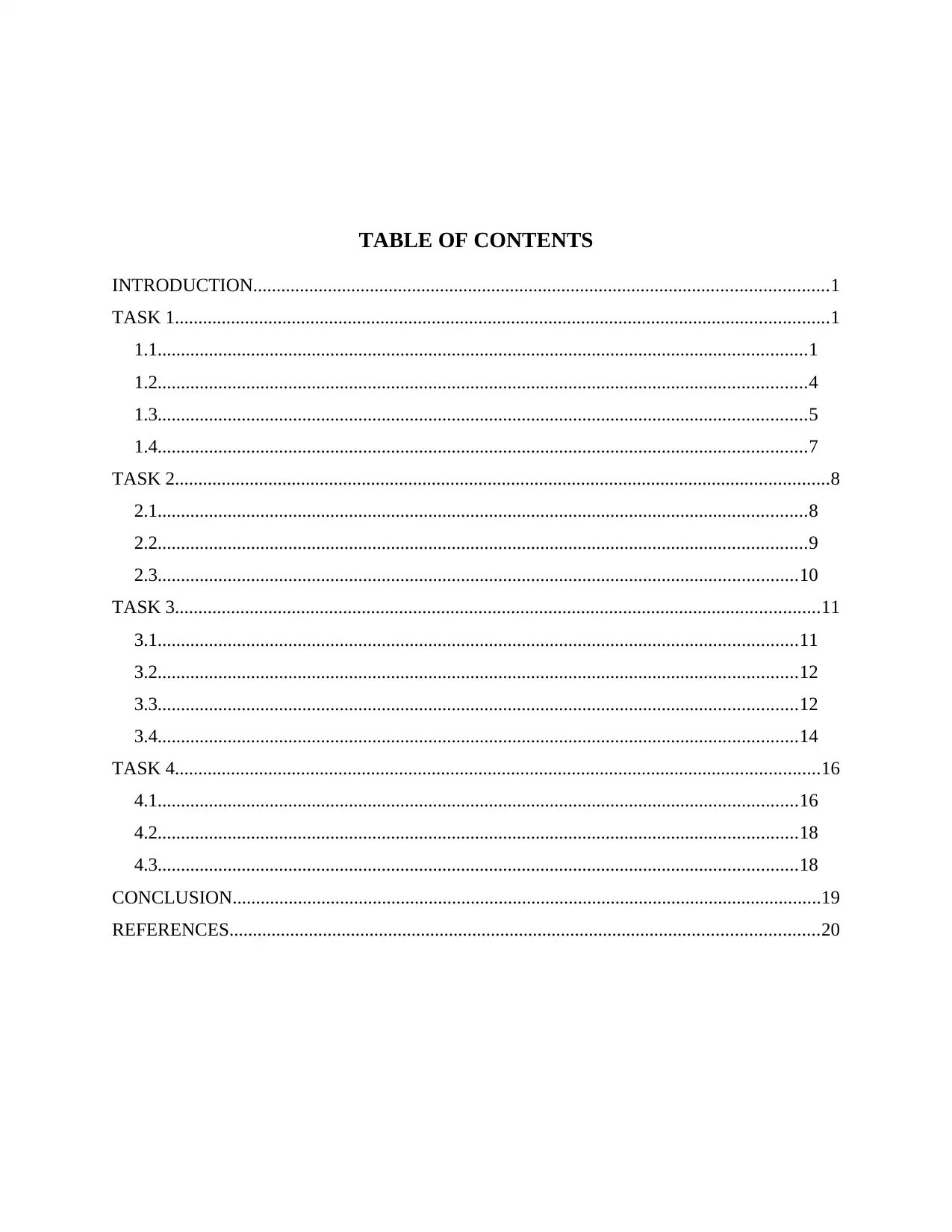
TABLE OF CONTENTS
INTRODUCTION...........................................................................................................................1
TASK 1............................................................................................................................................1
1.1...........................................................................................................................................1
1.2...........................................................................................................................................4
1.3...........................................................................................................................................5
1.4...........................................................................................................................................7
TASK 2............................................................................................................................................8
2.1...........................................................................................................................................8
2.2...........................................................................................................................................9
2.3.........................................................................................................................................10
TASK 3..........................................................................................................................................11
3.1.........................................................................................................................................11
3.2.........................................................................................................................................12
3.3.........................................................................................................................................12
3.4.........................................................................................................................................14
TASK 4..........................................................................................................................................16
4.1.........................................................................................................................................16
4.2.........................................................................................................................................18
4.3.........................................................................................................................................18
CONCLUSION..............................................................................................................................19
REFERENCES..............................................................................................................................20
INTRODUCTION...........................................................................................................................1
TASK 1............................................................................................................................................1
1.1...........................................................................................................................................1
1.2...........................................................................................................................................4
1.3...........................................................................................................................................5
1.4...........................................................................................................................................7
TASK 2............................................................................................................................................8
2.1...........................................................................................................................................8
2.2...........................................................................................................................................9
2.3.........................................................................................................................................10
TASK 3..........................................................................................................................................11
3.1.........................................................................................................................................11
3.2.........................................................................................................................................12
3.3.........................................................................................................................................12
3.4.........................................................................................................................................14
TASK 4..........................................................................................................................................16
4.1.........................................................................................................................................16
4.2.........................................................................................................................................18
4.3.........................................................................................................................................18
CONCLUSION..............................................................................................................................19
REFERENCES..............................................................................................................................20

INTRODUCTION
Effective decision making is an essential part of business unit if an organization wants to
survive in competitive and continually changing environment. For getting profits sound
judgement, information regarding economic positioning, interpretation, analysis and evaluation
of financial resources are very important aspects. With the use of financial analysis techniques
managers can control the cost of operations and can plan the business activities which can
provide optimistic outcomes to entity (Dechow and Skinner, 2000). For the present report Jeffrey
and Son's Ltd is taken into account, it produces exquisite products. Current report will discuss
the various management tools like budgeting process, cost sheet which can be beneficial for the
enterprise. Purpose of the assignment is to determine importance of management accounting and
cost budgeting in context to Jeffrey and Son's Ltd. Various calculations will be illustrated for
achieving the aim of the report by following given scenario.
TASK 1
1.1
For getting positive results corporations sacrifice resource like for the production of any
electrical product company requires electricity, raw material etc. These are the necessary
expenses for the business unit called as cost of entity. There are various types of costs are
included in the enterprise are described below:
Categorization Type of costs
Elements Material, labour and overhead costs are
included in this element.
In Jeffrey and Son's Ltd material costs
are as raw substantial which are
necessary for producing final good and
services. Like for manufacturing of
furniture company requires timber, this
is the cost of material for the entity.
Enterprise requires to purchase fabrics
for manufacturing of cloths so this also
Effective decision making is an essential part of business unit if an organization wants to
survive in competitive and continually changing environment. For getting profits sound
judgement, information regarding economic positioning, interpretation, analysis and evaluation
of financial resources are very important aspects. With the use of financial analysis techniques
managers can control the cost of operations and can plan the business activities which can
provide optimistic outcomes to entity (Dechow and Skinner, 2000). For the present report Jeffrey
and Son's Ltd is taken into account, it produces exquisite products. Current report will discuss
the various management tools like budgeting process, cost sheet which can be beneficial for the
enterprise. Purpose of the assignment is to determine importance of management accounting and
cost budgeting in context to Jeffrey and Son's Ltd. Various calculations will be illustrated for
achieving the aim of the report by following given scenario.
TASK 1
1.1
For getting positive results corporations sacrifice resource like for the production of any
electrical product company requires electricity, raw material etc. These are the necessary
expenses for the business unit called as cost of entity. There are various types of costs are
included in the enterprise are described below:
Categorization Type of costs
Elements Material, labour and overhead costs are
included in this element.
In Jeffrey and Son's Ltd material costs
are as raw substantial which are
necessary for producing final good and
services. Like for manufacturing of
furniture company requires timber, this
is the cost of material for the entity.
Enterprise requires to purchase fabrics
for manufacturing of cloths so this also
⊘ This is a preview!⊘
Do you want full access?
Subscribe today to unlock all pages.

Trusted by 1+ million students worldwide
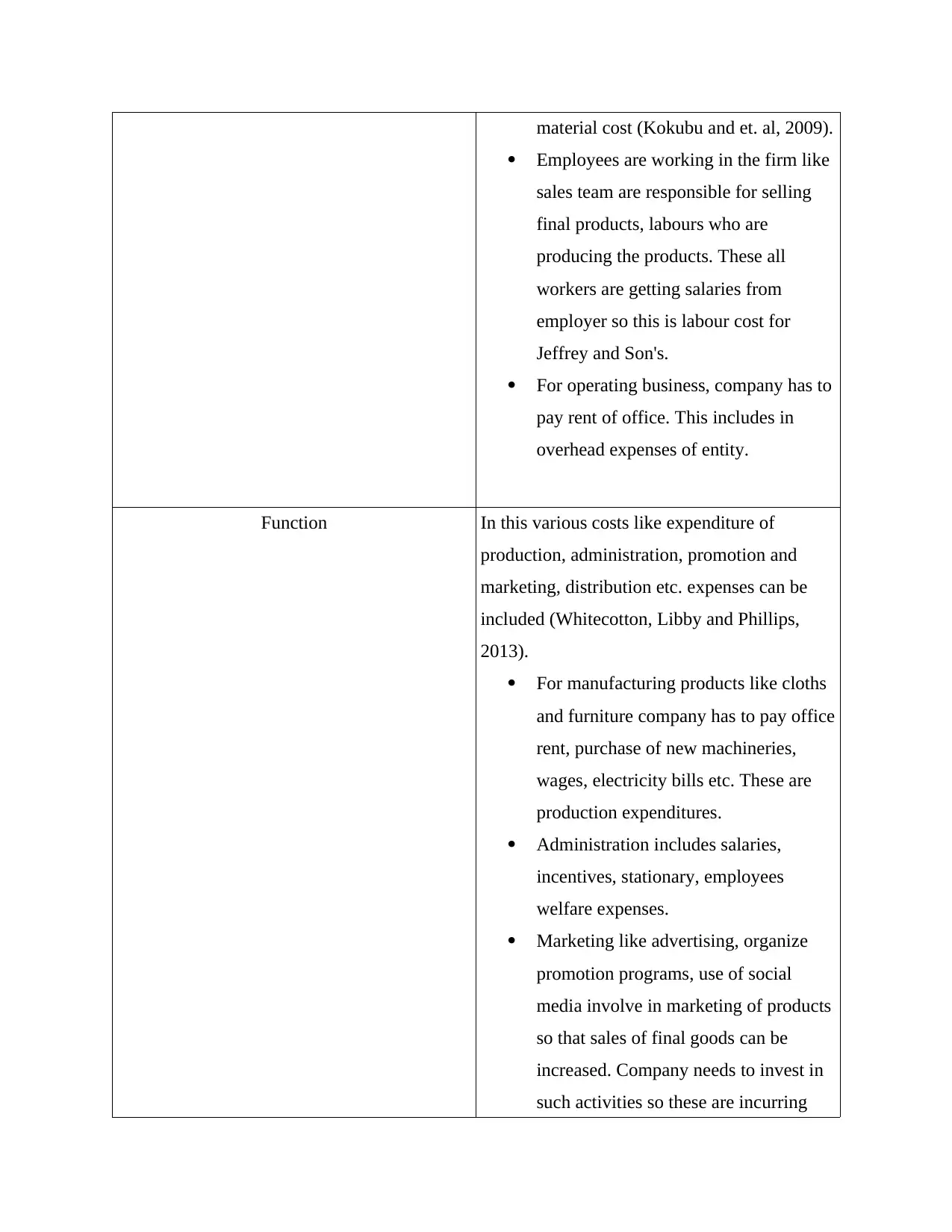
material cost (Kokubu and et. al, 2009).
Employees are working in the firm like
sales team are responsible for selling
final products, labours who are
producing the products. These all
workers are getting salaries from
employer so this is labour cost for
Jeffrey and Son's.
For operating business, company has to
pay rent of office. This includes in
overhead expenses of entity.
Function In this various costs like expenditure of
production, administration, promotion and
marketing, distribution etc. expenses can be
included (Whitecotton, Libby and Phillips,
2013).
For manufacturing products like cloths
and furniture company has to pay office
rent, purchase of new machineries,
wages, electricity bills etc. These are
production expenditures.
Administration includes salaries,
incentives, stationary, employees
welfare expenses.
Marketing like advertising, organize
promotion programs, use of social
media involve in marketing of products
so that sales of final goods can be
increased. Company needs to invest in
such activities so these are incurring
Employees are working in the firm like
sales team are responsible for selling
final products, labours who are
producing the products. These all
workers are getting salaries from
employer so this is labour cost for
Jeffrey and Son's.
For operating business, company has to
pay rent of office. This includes in
overhead expenses of entity.
Function In this various costs like expenditure of
production, administration, promotion and
marketing, distribution etc. expenses can be
included (Whitecotton, Libby and Phillips,
2013).
For manufacturing products like cloths
and furniture company has to pay office
rent, purchase of new machineries,
wages, electricity bills etc. These are
production expenditures.
Administration includes salaries,
incentives, stationary, employees
welfare expenses.
Marketing like advertising, organize
promotion programs, use of social
media involve in marketing of products
so that sales of final goods can be
increased. Company needs to invest in
such activities so these are incurring
Paraphrase This Document
Need a fresh take? Get an instant paraphrase of this document with our AI Paraphraser
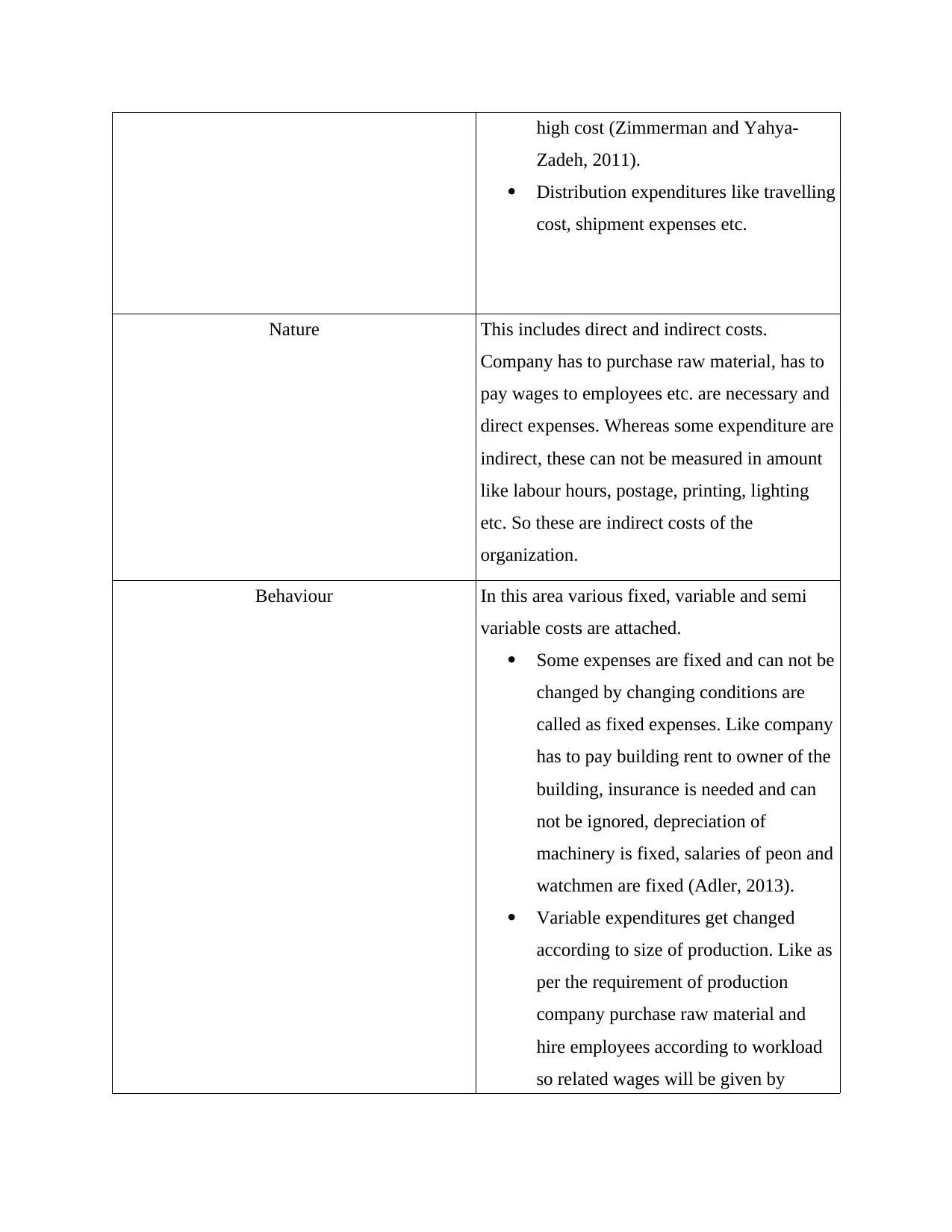
high cost (Zimmerman and Yahya-
Zadeh, 2011).
Distribution expenditures like travelling
cost, shipment expenses etc.
Nature This includes direct and indirect costs.
Company has to purchase raw material, has to
pay wages to employees etc. are necessary and
direct expenses. Whereas some expenditure are
indirect, these can not be measured in amount
like labour hours, postage, printing, lighting
etc. So these are indirect costs of the
organization.
Behaviour In this area various fixed, variable and semi
variable costs are attached.
Some expenses are fixed and can not be
changed by changing conditions are
called as fixed expenses. Like company
has to pay building rent to owner of the
building, insurance is needed and can
not be ignored, depreciation of
machinery is fixed, salaries of peon and
watchmen are fixed (Adler, 2013).
Variable expenditures get changed
according to size of production. Like as
per the requirement of production
company purchase raw material and
hire employees according to workload
so related wages will be given by
Zadeh, 2011).
Distribution expenditures like travelling
cost, shipment expenses etc.
Nature This includes direct and indirect costs.
Company has to purchase raw material, has to
pay wages to employees etc. are necessary and
direct expenses. Whereas some expenditure are
indirect, these can not be measured in amount
like labour hours, postage, printing, lighting
etc. So these are indirect costs of the
organization.
Behaviour In this area various fixed, variable and semi
variable costs are attached.
Some expenses are fixed and can not be
changed by changing conditions are
called as fixed expenses. Like company
has to pay building rent to owner of the
building, insurance is needed and can
not be ignored, depreciation of
machinery is fixed, salaries of peon and
watchmen are fixed (Adler, 2013).
Variable expenditures get changed
according to size of production. Like as
per the requirement of production
company purchase raw material and
hire employees according to workload
so related wages will be given by
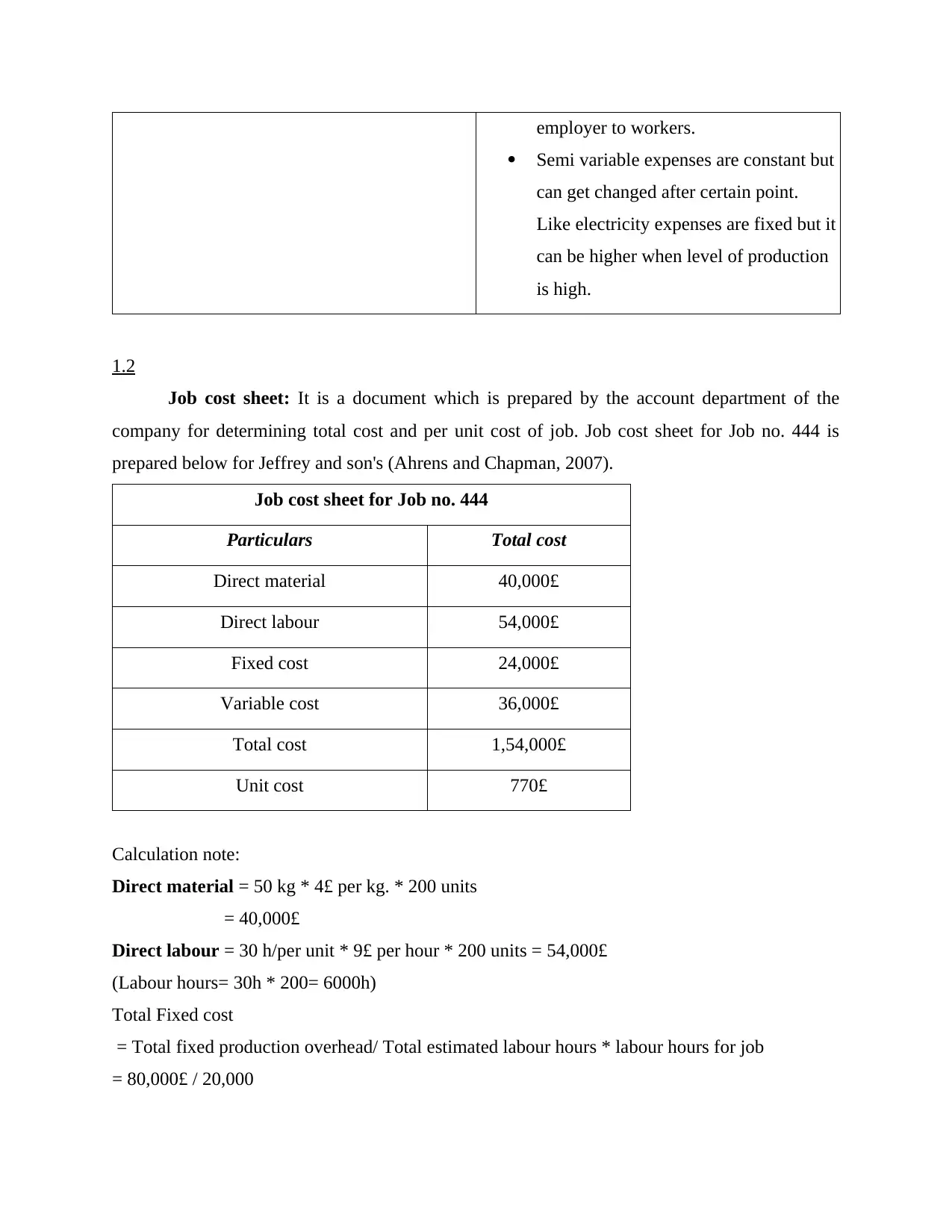
employer to workers.
Semi variable expenses are constant but
can get changed after certain point.
Like electricity expenses are fixed but it
can be higher when level of production
is high.
1.2
Job cost sheet: It is a document which is prepared by the account department of the
company for determining total cost and per unit cost of job. Job cost sheet for Job no. 444 is
prepared below for Jeffrey and son's (Ahrens and Chapman, 2007).
Job cost sheet for Job no. 444
Particulars Total cost
Direct material 40,000£
Direct labour 54,000£
Fixed cost 24,000£
Variable cost 36,000£
Total cost 1,54,000£
Unit cost 770£
Calculation note:
Direct material = 50 kg * 4£ per kg. * 200 units
= 40,000£
Direct labour = 30 h/per unit * 9£ per hour * 200 units = 54,000£
(Labour hours= 30h * 200= 6000h)
Total Fixed cost
= Total fixed production overhead/ Total estimated labour hours * labour hours for job
= 80,000£ / 20,000
Semi variable expenses are constant but
can get changed after certain point.
Like electricity expenses are fixed but it
can be higher when level of production
is high.
1.2
Job cost sheet: It is a document which is prepared by the account department of the
company for determining total cost and per unit cost of job. Job cost sheet for Job no. 444 is
prepared below for Jeffrey and son's (Ahrens and Chapman, 2007).
Job cost sheet for Job no. 444
Particulars Total cost
Direct material 40,000£
Direct labour 54,000£
Fixed cost 24,000£
Variable cost 36,000£
Total cost 1,54,000£
Unit cost 770£
Calculation note:
Direct material = 50 kg * 4£ per kg. * 200 units
= 40,000£
Direct labour = 30 h/per unit * 9£ per hour * 200 units = 54,000£
(Labour hours= 30h * 200= 6000h)
Total Fixed cost
= Total fixed production overhead/ Total estimated labour hours * labour hours for job
= 80,000£ / 20,000
⊘ This is a preview!⊘
Do you want full access?
Subscribe today to unlock all pages.

Trusted by 1+ million students worldwide
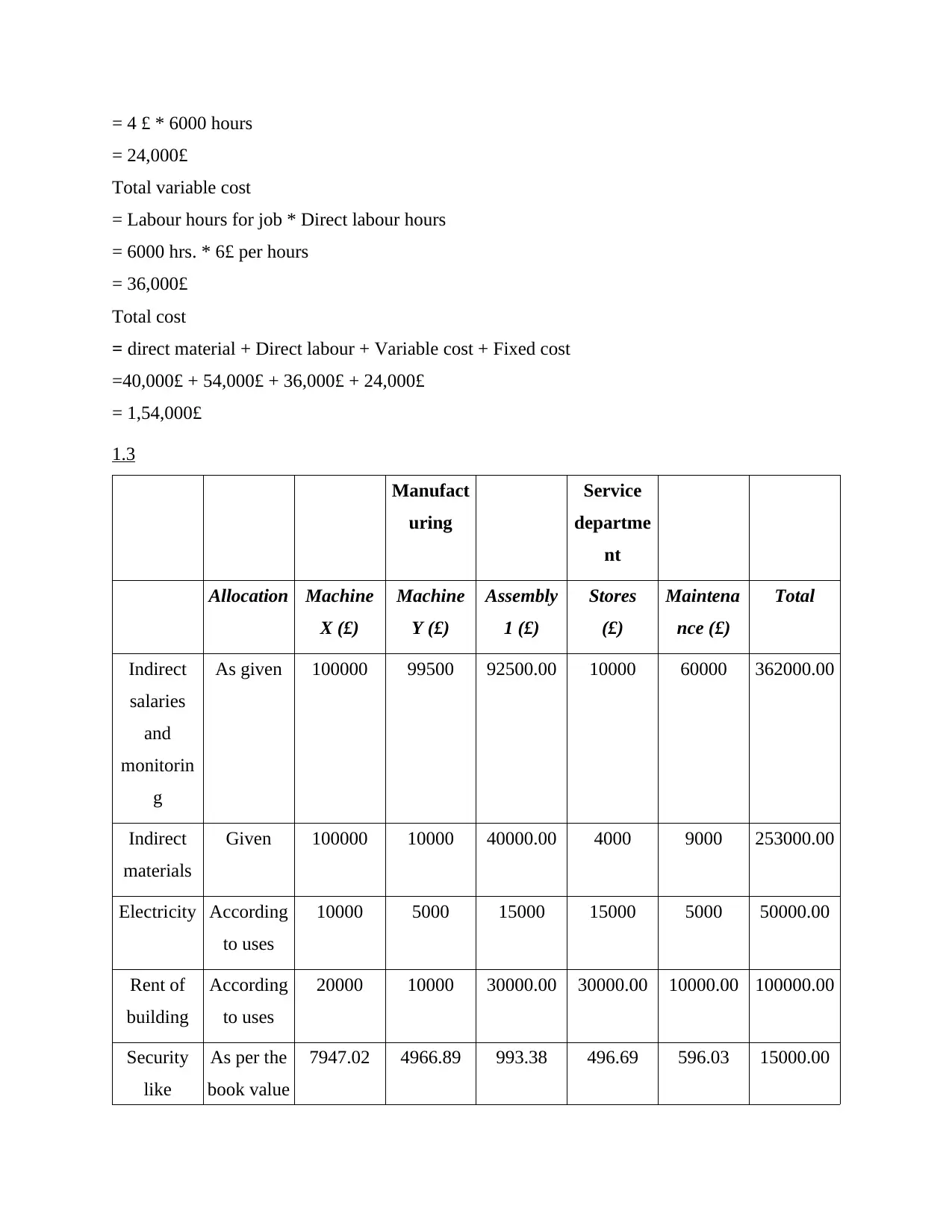
= 4 £ * 6000 hours
= 24,000£
Total variable cost
= Labour hours for job * Direct labour hours
= 6000 hrs. * 6£ per hours
= 36,000£
Total cost
= direct material + Direct labour + Variable cost + Fixed cost
=40,000£ + 54,000£ + 36,000£ + 24,000£
= 1,54,000£
1.3
Manufact
uring
Service
departme
nt
Allocation Machine
X (£)
Machine
Y (£)
Assembly
1 (£)
Stores
(£)
Maintena
nce (£)
Total
Indirect
salaries
and
monitorin
g
As given 100000 99500 92500.00 10000 60000 362000.00
Indirect
materials
Given 100000 10000 40000.00 4000 9000 253000.00
Electricity According
to uses
10000 5000 15000 15000 5000 50000.00
Rent of
building
According
to uses
20000 10000 30000.00 30000.00 10000.00 100000.00
Security
like
As per the
book value
7947.02 4966.89 993.38 496.69 596.03 15000.00
= 24,000£
Total variable cost
= Labour hours for job * Direct labour hours
= 6000 hrs. * 6£ per hours
= 36,000£
Total cost
= direct material + Direct labour + Variable cost + Fixed cost
=40,000£ + 54,000£ + 36,000£ + 24,000£
= 1,54,000£
1.3
Manufact
uring
Service
departme
nt
Allocation Machine
X (£)
Machine
Y (£)
Assembly
1 (£)
Stores
(£)
Maintena
nce (£)
Total
Indirect
salaries
and
monitorin
g
As given 100000 99500 92500.00 10000 60000 362000.00
Indirect
materials
Given 100000 10000 40000.00 4000 9000 253000.00
Electricity According
to uses
10000 5000 15000 15000 5000 50000.00
Rent of
building
According
to uses
20000 10000 30000.00 30000.00 10000.00 100000.00
Security
like
As per the
book value
7947.02 4966.89 993.38 496.69 596.03 15000.00
Paraphrase This Document
Need a fresh take? Get an instant paraphrase of this document with our AI Paraphraser
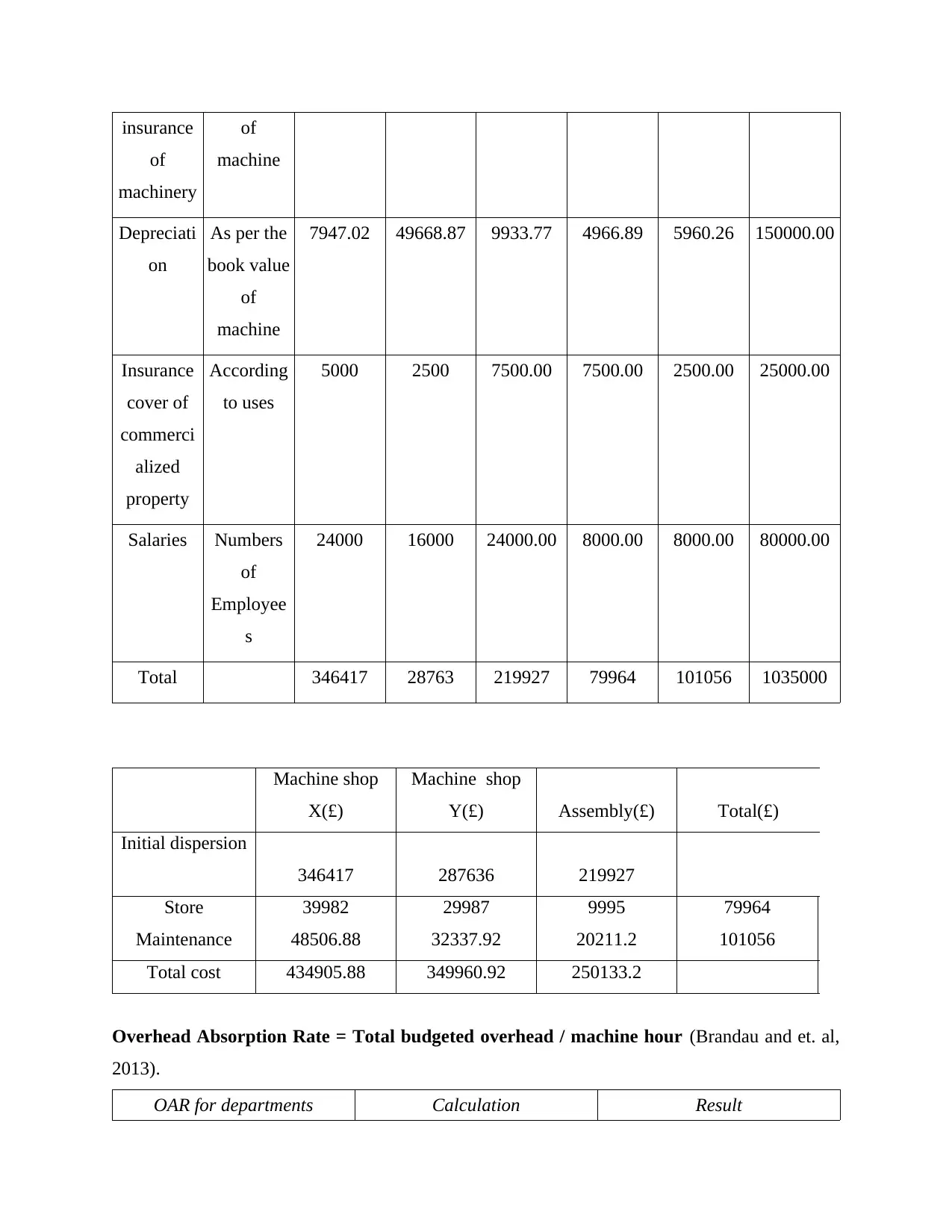
insurance
of
machinery
of
machine
Depreciati
on
As per the
book value
of
machine
7947.02 49668.87 9933.77 4966.89 5960.26 150000.00
Insurance
cover of
commerci
alized
property
According
to uses
5000 2500 7500.00 7500.00 2500.00 25000.00
Salaries Numbers
of
Employee
s
24000 16000 24000.00 8000.00 8000.00 80000.00
Total 346417 28763 219927 79964 101056 1035000
Machine shop
X(£)
Machine shop
Y(£) Assembly(£) Total(£)
Initial dispersion
346417 287636 219927
Store 39982 29987 9995 79964
Maintenance 48506.88 32337.92 20211.2 101056
Total cost 434905.88 349960.92 250133.2
Overhead Absorption Rate = Total budgeted overhead / machine hour (Brandau and et. al,
2013).
OAR for departments Calculation Result
of
machinery
of
machine
Depreciati
on
As per the
book value
of
machine
7947.02 49668.87 9933.77 4966.89 5960.26 150000.00
Insurance
cover of
commerci
alized
property
According
to uses
5000 2500 7500.00 7500.00 2500.00 25000.00
Salaries Numbers
of
Employee
s
24000 16000 24000.00 8000.00 8000.00 80000.00
Total 346417 28763 219927 79964 101056 1035000
Machine shop
X(£)
Machine shop
Y(£) Assembly(£) Total(£)
Initial dispersion
346417 287636 219927
Store 39982 29987 9995 79964
Maintenance 48506.88 32337.92 20211.2 101056
Total cost 434905.88 349960.92 250133.2
Overhead Absorption Rate = Total budgeted overhead / machine hour (Brandau and et. al,
2013).
OAR for departments Calculation Result
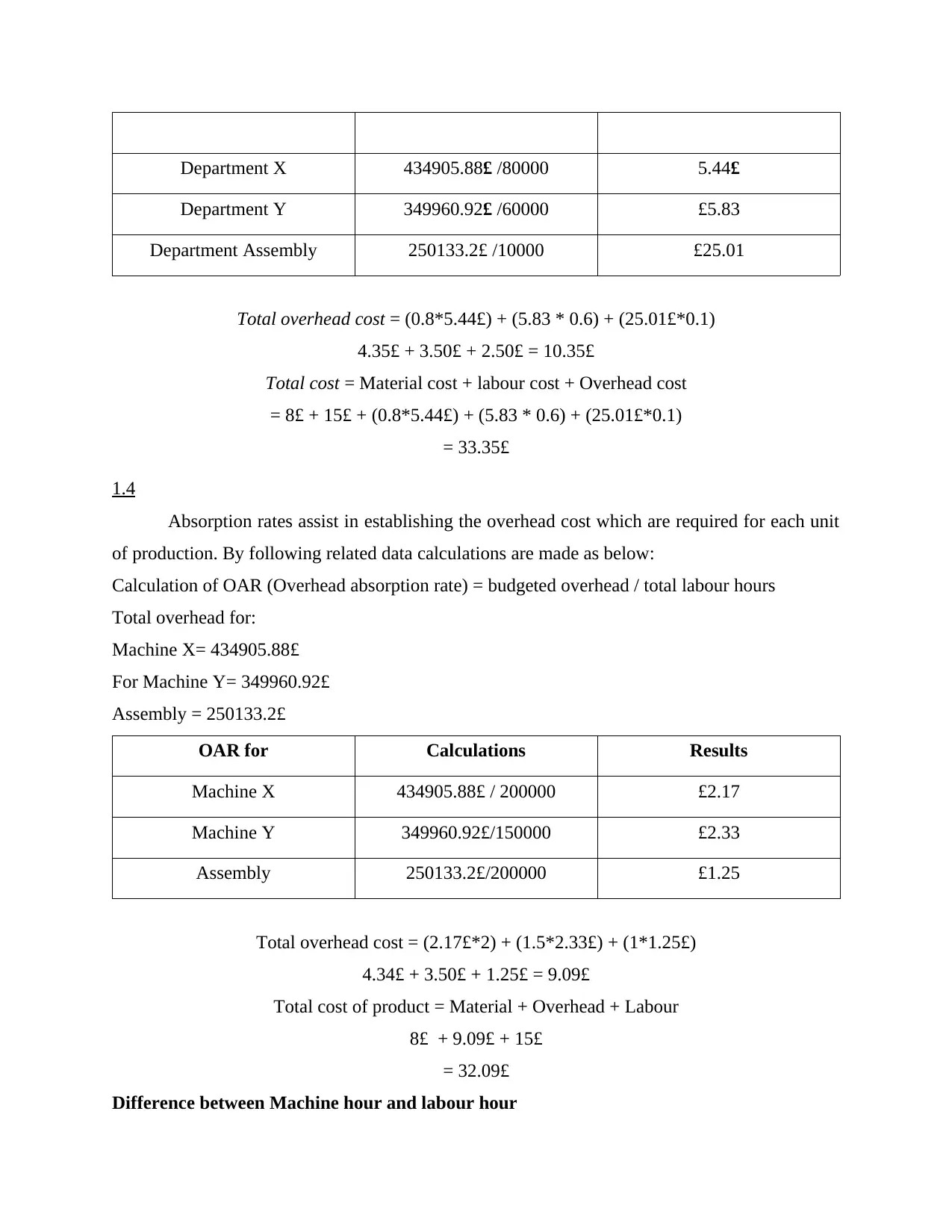
Department X 434905.88£ /80000 5.44£
Department Y 349960.92£ /60000 £5.83
Department Assembly 250133.2£ /10000 £25.01
Total overhead cost = (0.8*5.44£) + (5.83 * 0.6) + (25.01£*0.1)
4.35£ + 3.50£ + 2.50£ = 10.35£
Total cost = Material cost + labour cost + Overhead cost
= 8£ + 15£ + (0.8*5.44£) + (5.83 * 0.6) + (25.01£*0.1)
= 33.35£
1.4
Absorption rates assist in establishing the overhead cost which are required for each unit
of production. By following related data calculations are made as below:
Calculation of OAR (Overhead absorption rate) = budgeted overhead / total labour hours
Total overhead for:
Machine X= 434905.88£
For Machine Y= 349960.92£
Assembly = 250133.2£
OAR for Calculations Results
Machine X 434905.88£ / 200000 £2.17
Machine Y 349960.92£/150000 £2.33
Assembly 250133.2£/200000 £1.25
Total overhead cost = (2.17£*2) + (1.5*2.33£) + (1*1.25£)
4.34£ + 3.50£ + 1.25£ = 9.09£
Total cost of product = Material + Overhead + Labour
8£ + 9.09£ + 15£
= 32.09£
Difference between Machine hour and labour hour
Department Y 349960.92£ /60000 £5.83
Department Assembly 250133.2£ /10000 £25.01
Total overhead cost = (0.8*5.44£) + (5.83 * 0.6) + (25.01£*0.1)
4.35£ + 3.50£ + 2.50£ = 10.35£
Total cost = Material cost + labour cost + Overhead cost
= 8£ + 15£ + (0.8*5.44£) + (5.83 * 0.6) + (25.01£*0.1)
= 33.35£
1.4
Absorption rates assist in establishing the overhead cost which are required for each unit
of production. By following related data calculations are made as below:
Calculation of OAR (Overhead absorption rate) = budgeted overhead / total labour hours
Total overhead for:
Machine X= 434905.88£
For Machine Y= 349960.92£
Assembly = 250133.2£
OAR for Calculations Results
Machine X 434905.88£ / 200000 £2.17
Machine Y 349960.92£/150000 £2.33
Assembly 250133.2£/200000 £1.25
Total overhead cost = (2.17£*2) + (1.5*2.33£) + (1*1.25£)
4.34£ + 3.50£ + 1.25£ = 9.09£
Total cost of product = Material + Overhead + Labour
8£ + 9.09£ + 15£
= 32.09£
Difference between Machine hour and labour hour
⊘ This is a preview!⊘
Do you want full access?
Subscribe today to unlock all pages.

Trusted by 1+ million students worldwide
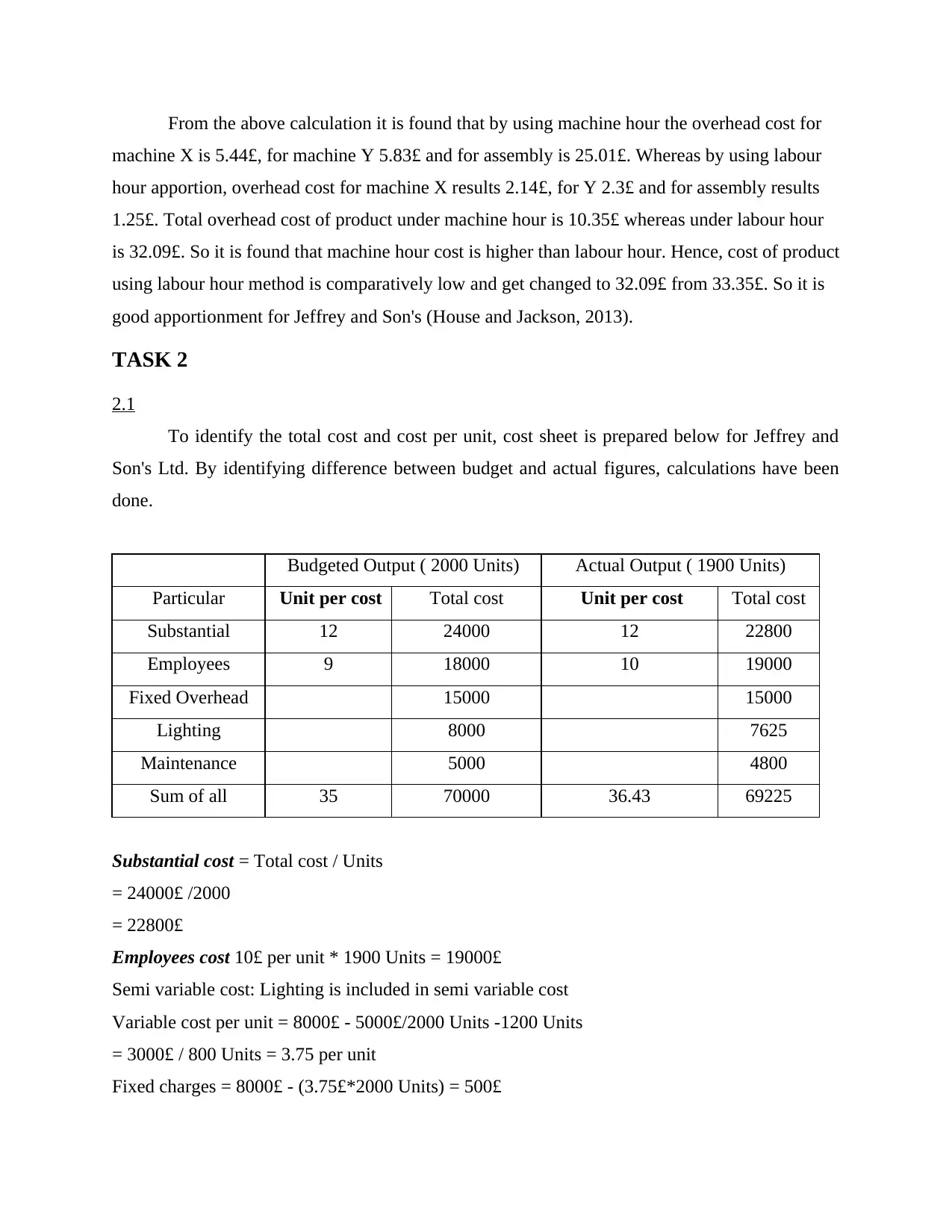
From the above calculation it is found that by using machine hour the overhead cost for
machine X is 5.44£, for machine Y 5.83£ and for assembly is 25.01£. Whereas by using labour
hour apportion, overhead cost for machine X results 2.14£, for Y 2.3£ and for assembly results
1.25£. Total overhead cost of product under machine hour is 10.35£ whereas under labour hour
is 32.09£. So it is found that machine hour cost is higher than labour hour. Hence, cost of product
using labour hour method is comparatively low and get changed to 32.09£ from 33.35£. So it is
good apportionment for Jeffrey and Son's (House and Jackson, 2013).
TASK 2
2.1
To identify the total cost and cost per unit, cost sheet is prepared below for Jeffrey and
Son's Ltd. By identifying difference between budget and actual figures, calculations have been
done.
Budgeted Output ( 2000 Units) Actual Output ( 1900 Units)
Particular Unit per cost Total cost Unit per cost Total cost
Substantial 12 24000 12 22800
Employees 9 18000 10 19000
Fixed Overhead 15000 15000
Lighting 8000 7625
Maintenance 5000 4800
Sum of all 35 70000 36.43 69225
Substantial cost = Total cost / Units
= 24000£ /2000
= 22800£
Employees cost 10£ per unit * 1900 Units = 19000£
Semi variable cost: Lighting is included in semi variable cost
Variable cost per unit = 8000£ - 5000£/2000 Units -1200 Units
= 3000£ / 800 Units = 3.75 per unit
Fixed charges = 8000£ - (3.75£*2000 Units) = 500£
machine X is 5.44£, for machine Y 5.83£ and for assembly is 25.01£. Whereas by using labour
hour apportion, overhead cost for machine X results 2.14£, for Y 2.3£ and for assembly results
1.25£. Total overhead cost of product under machine hour is 10.35£ whereas under labour hour
is 32.09£. So it is found that machine hour cost is higher than labour hour. Hence, cost of product
using labour hour method is comparatively low and get changed to 32.09£ from 33.35£. So it is
good apportionment for Jeffrey and Son's (House and Jackson, 2013).
TASK 2
2.1
To identify the total cost and cost per unit, cost sheet is prepared below for Jeffrey and
Son's Ltd. By identifying difference between budget and actual figures, calculations have been
done.
Budgeted Output ( 2000 Units) Actual Output ( 1900 Units)
Particular Unit per cost Total cost Unit per cost Total cost
Substantial 12 24000 12 22800
Employees 9 18000 10 19000
Fixed Overhead 15000 15000
Lighting 8000 7625
Maintenance 5000 4800
Sum of all 35 70000 36.43 69225
Substantial cost = Total cost / Units
= 24000£ /2000
= 22800£
Employees cost 10£ per unit * 1900 Units = 19000£
Semi variable cost: Lighting is included in semi variable cost
Variable cost per unit = 8000£ - 5000£/2000 Units -1200 Units
= 3000£ / 800 Units = 3.75 per unit
Fixed charges = 8000£ - (3.75£*2000 Units) = 500£
Paraphrase This Document
Need a fresh take? Get an instant paraphrase of this document with our AI Paraphraser

Variable electricity charges = 3.75£*1900 Units
= 7125£
Total charges of lighting = 7125£ + 500£
= 7625£
Maintenance cost = 5000£ - (1000£/500 units*100 Units) = 4800£
Cost per unit = 69225£/1900 Units = 36.43£
Calculation of Variance analysis:
It concerns with the financial performance of deviations, by this calculation company
analysis difference between flexed standards and actual results (Kurichi and et. al, 2013).
Particular Budgeted cost Real cost Variance
Substantial 24000 22800 1200
Employees 18000 19000 -1000
Fixed Overhead 15000 15000 0
Lighting 8000 7625 375
Maintenance 5000 4800 200
Total 70000 69225 775
Interpretation: Substantial variance indicates that Jeffrey and Son's Ltd. Actual cost is lower
than budgeted cost. So price variance of material is zero because it is same to 12£. Labour
variance shows that it is higher than budgeted cost. It increased due to the higher labour rate
which is 10£ per unit. As lighting budgeted cost was 8000 but it is getting declined to 7625. So
there is positive variance that is 375. Because of lower production maintenance rate get affected.
Budgeted cost of maintenance was 5000 but actual was 4800 so variance arises to 200£. As fixed
cost remains same therefore fixed cost variance also remains same under the output of 2000 and
1900 Units. Thus, it may be said that labour cost variance, labour rate and material cost variance
impact negatively on business unit. It reduces the profitability margin of the company to the
great extend. For making good profits Jeffrey and Son's has to search alternatives so that these
negative areas can be decreased and enterprise get high profit (Johnson, Pfeiffer and Schneider,
2013).
= 7125£
Total charges of lighting = 7125£ + 500£
= 7625£
Maintenance cost = 5000£ - (1000£/500 units*100 Units) = 4800£
Cost per unit = 69225£/1900 Units = 36.43£
Calculation of Variance analysis:
It concerns with the financial performance of deviations, by this calculation company
analysis difference between flexed standards and actual results (Kurichi and et. al, 2013).
Particular Budgeted cost Real cost Variance
Substantial 24000 22800 1200
Employees 18000 19000 -1000
Fixed Overhead 15000 15000 0
Lighting 8000 7625 375
Maintenance 5000 4800 200
Total 70000 69225 775
Interpretation: Substantial variance indicates that Jeffrey and Son's Ltd. Actual cost is lower
than budgeted cost. So price variance of material is zero because it is same to 12£. Labour
variance shows that it is higher than budgeted cost. It increased due to the higher labour rate
which is 10£ per unit. As lighting budgeted cost was 8000 but it is getting declined to 7625. So
there is positive variance that is 375. Because of lower production maintenance rate get affected.
Budgeted cost of maintenance was 5000 but actual was 4800 so variance arises to 200£. As fixed
cost remains same therefore fixed cost variance also remains same under the output of 2000 and
1900 Units. Thus, it may be said that labour cost variance, labour rate and material cost variance
impact negatively on business unit. It reduces the profitability margin of the company to the
great extend. For making good profits Jeffrey and Son's has to search alternatives so that these
negative areas can be decreased and enterprise get high profit (Johnson, Pfeiffer and Schneider,
2013).
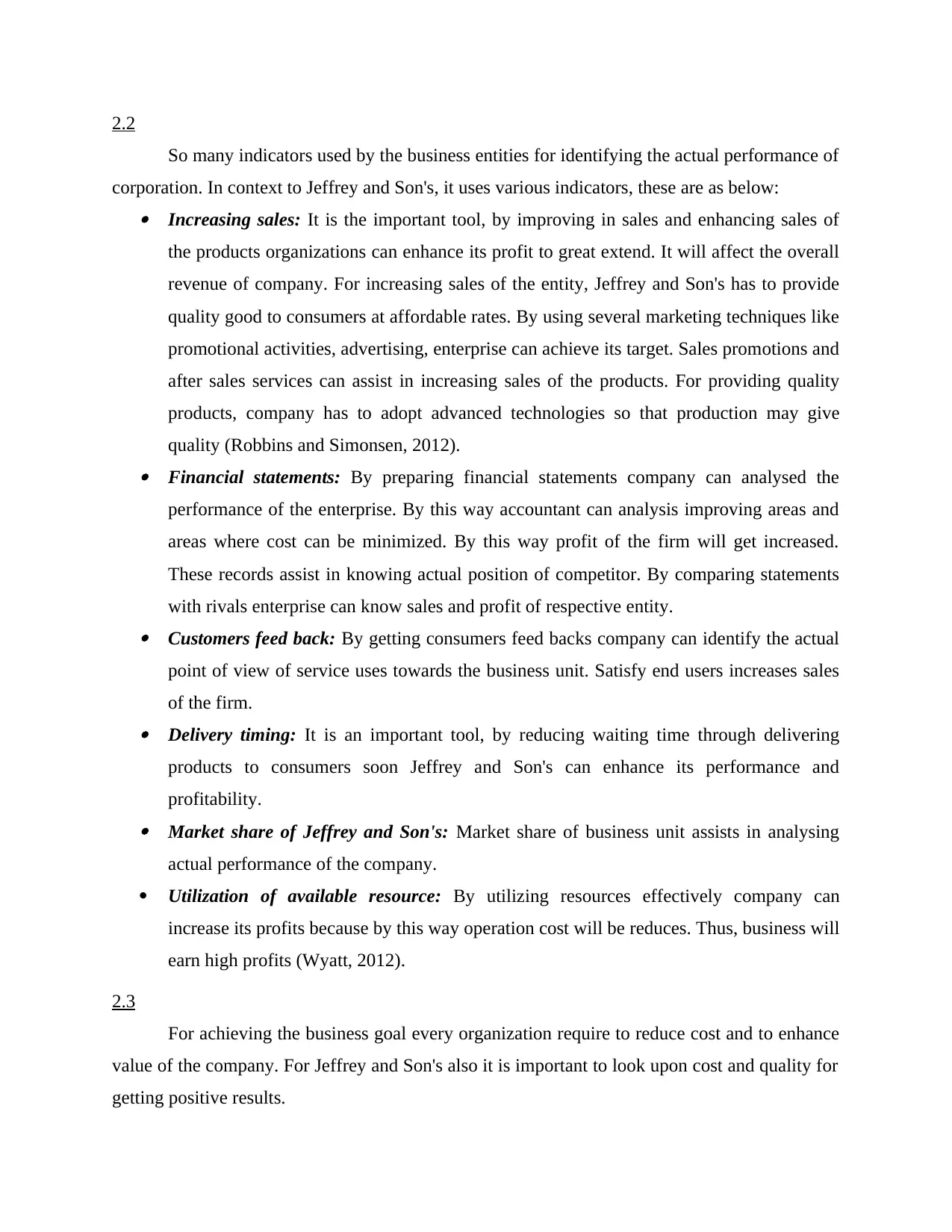
2.2
So many indicators used by the business entities for identifying the actual performance of
corporation. In context to Jeffrey and Son's, it uses various indicators, these are as below: Increasing sales: It is the important tool, by improving in sales and enhancing sales of
the products organizations can enhance its profit to great extend. It will affect the overall
revenue of company. For increasing sales of the entity, Jeffrey and Son's has to provide
quality good to consumers at affordable rates. By using several marketing techniques like
promotional activities, advertising, enterprise can achieve its target. Sales promotions and
after sales services can assist in increasing sales of the products. For providing quality
products, company has to adopt advanced technologies so that production may give
quality (Robbins and Simonsen, 2012). Financial statements: By preparing financial statements company can analysed the
performance of the enterprise. By this way accountant can analysis improving areas and
areas where cost can be minimized. By this way profit of the firm will get increased.
These records assist in knowing actual position of competitor. By comparing statements
with rivals enterprise can know sales and profit of respective entity. Customers feed back: By getting consumers feed backs company can identify the actual
point of view of service uses towards the business unit. Satisfy end users increases sales
of the firm. Delivery timing: It is an important tool, by reducing waiting time through delivering
products to consumers soon Jeffrey and Son's can enhance its performance and
profitability. Market share of Jeffrey and Son's: Market share of business unit assists in analysing
actual performance of the company.
Utilization of available resource: By utilizing resources effectively company can
increase its profits because by this way operation cost will be reduces. Thus, business will
earn high profits (Wyatt, 2012).
2.3
For achieving the business goal every organization require to reduce cost and to enhance
value of the company. For Jeffrey and Son's also it is important to look upon cost and quality for
getting positive results.
So many indicators used by the business entities for identifying the actual performance of
corporation. In context to Jeffrey and Son's, it uses various indicators, these are as below: Increasing sales: It is the important tool, by improving in sales and enhancing sales of
the products organizations can enhance its profit to great extend. It will affect the overall
revenue of company. For increasing sales of the entity, Jeffrey and Son's has to provide
quality good to consumers at affordable rates. By using several marketing techniques like
promotional activities, advertising, enterprise can achieve its target. Sales promotions and
after sales services can assist in increasing sales of the products. For providing quality
products, company has to adopt advanced technologies so that production may give
quality (Robbins and Simonsen, 2012). Financial statements: By preparing financial statements company can analysed the
performance of the enterprise. By this way accountant can analysis improving areas and
areas where cost can be minimized. By this way profit of the firm will get increased.
These records assist in knowing actual position of competitor. By comparing statements
with rivals enterprise can know sales and profit of respective entity. Customers feed back: By getting consumers feed backs company can identify the actual
point of view of service uses towards the business unit. Satisfy end users increases sales
of the firm. Delivery timing: It is an important tool, by reducing waiting time through delivering
products to consumers soon Jeffrey and Son's can enhance its performance and
profitability. Market share of Jeffrey and Son's: Market share of business unit assists in analysing
actual performance of the company.
Utilization of available resource: By utilizing resources effectively company can
increase its profits because by this way operation cost will be reduces. Thus, business will
earn high profits (Wyatt, 2012).
2.3
For achieving the business goal every organization require to reduce cost and to enhance
value of the company. For Jeffrey and Son's also it is important to look upon cost and quality for
getting positive results.
⊘ This is a preview!⊘
Do you want full access?
Subscribe today to unlock all pages.

Trusted by 1+ million students worldwide
1 out of 23
Related Documents
Your All-in-One AI-Powered Toolkit for Academic Success.
+13062052269
info@desklib.com
Available 24*7 on WhatsApp / Email
![[object Object]](/_next/static/media/star-bottom.7253800d.svg)
Unlock your academic potential
Copyright © 2020–2025 A2Z Services. All Rights Reserved. Developed and managed by ZUCOL.





